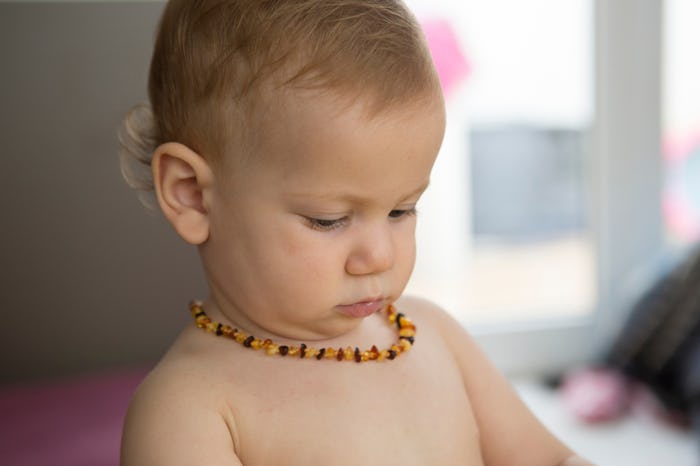News
FDA Issues A Strong Warning To Parents About These Popular Teething Necklaces
When it comes to teething, it's easy to understand how parents can feel desperate for pretty much any solution that gives their child a bit of relief, and them a few hours without having to comfort or distract them. There are many different approaches to take when trying to help your child through the pain of breaking through new teeth, but the FDA's warning about teething necklaces urges parents never to use the popular accessory.
According to a new release from the FDA on Thursday, Dec. 20, it is advised that parents do not use teething necklaces — which are different from teething rings that are chewed on — because it is ultimately a choking hazard, as TODAY reported.
"The FDA is alerting parents, caregivers, and health care providers that necklaces, bracelets, and other jewelry marketed for relieving teething pain should not be used with infants or to provide sensory stimulation to persons with special needs, such as autism or attention-deficit/hyperactivity disorder," the notice stated.
The warning continued, "Such use could lead to strangulation, choking, serious injuries, or death. The safety and effectiveness of teething jewelry to treat teething pain and/or provide sensory stimulation have not been established."
The FDA's warning also noted that it has "received reports of death and serious injuries to infants and children, including strangulation and choking, caused by necklaces and bracelets often marketed for relieving teething pain." The FDA added in its warning:
The risks of using teething jewelry include choking, strangulation, injury to the mouth, and infection. Choking may occur if the jewelry breaks and small beads or the whole piece of jewelry enter the child’s throat or airway.
The FDA also cited a report of an 18-month-old child who was tragically "strangled to death by his amber teething necklace during a nap."
However, so as to not completely leave you in the dark, the FDA also listed a number of remedies that are safe and pain free, such as the following:
- gently rubbing or massaging the gums with a clean finger
- giving the teething child a teething ring made of firm rubber
However, the FDA also noted to "make sure the teething ring is not frozen," because "if the object is too hard, it can hurt the child’s gums. Parents and caregivers should supervise the child during use."
In addition, the FDA warned to avoid "teething creams and benzocaine gels, sprays, ointments, solutions and lozenges for mouth and gum pain in infants and children younger than 2 years." The notice added, "Benzocaine and other local anesthetics can cause methemoglobinemia, a serious condition in which the amount of oxygen carried through the blood is reduced. This condition is life-threatening and can result in death."
Many parents may be familiar with the use of Baltic Amber necklaces in particular, a homeopathic remedy that, according to the American Academy of Pediatrics, is supposed to release succinic acid into the bloodstream when warmed by the baby's body heat. The acid is supposed to help relieve the baby's pain.
However, according to The Bump, there is no scientific evidence yet backing up that this method is effective in any way. It may be anecdotal, or there may be some legitimacy to the claim, however, until scientific research is done, there's no way to know for sure.
Regardless, the most important thing to remember is that the issue at hand is that necklaces can pose a dangerous threat for young babies who are just learning to move around on their own. This means that teething necklaces or jewelry should not be worn without supervision, overnight, or consistently/long-term. The same could easily apply to wearing a necklace wrapped around a limb, such as an ankle or wrist.
With all this said, parents should be sure to consult their pediatricians to find the most effective and safe pain management for their babies as they teethe. It's a challenging time for sure, but there are definitely options out there to ease the ache.
